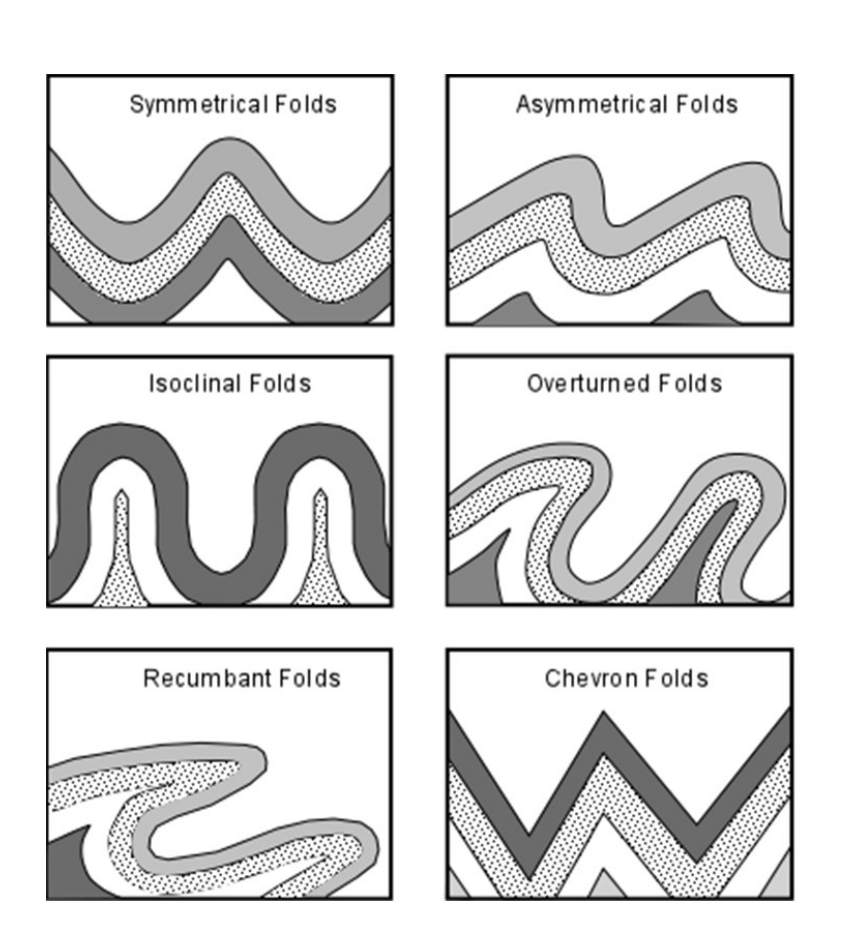L2 Bedrock geology of Sweden
1/23
Earn XP
Description and Tags
AE1106 course
Name | Mastery | Learn | Test | Matching | Spaced |
|---|
No study sessions yet.
24 Terms
Name the 6 geological provinces of Sweden
Archean Province – Northernmost Sweden, with the oldest rocks
Svecofennian Province– Central and northern Sweden, rocks formed during the Svecofennian orogeny
Transscandinavian Igneous Belt – Granitoids and porphyries formed, mainly in south-central Sweden.
Southwestern scandinavian Province (Sveconorwegian Province ) – Complexly deformed rocks in southwestern Sweden, affected by Gothian and Sveconorwegian orogenies
Caledonides - Western Sweden, thrust nappes formed during the Caledonian orogeny
Sedimentary cover rocks (mainly Palezoic in south and in baltic sea) - Mainly southern Sweden (e.g., Skåne), consisting of Cambro-Silurian to Mesozoic–Cenozoic sediments.
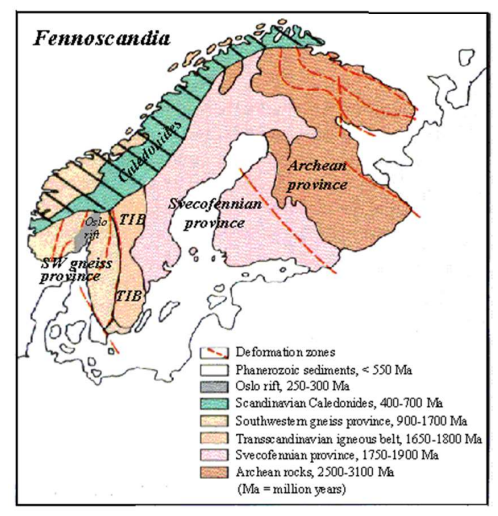
Provide the approximate age ranges of the 6 geological provinces in Sweden
Archean Province: 3.1–2.5 Ga (billion years ago)
Svecofennian Province: ~2.0–1.8 Ga
Transscandinavian Igenous Belt: ~1.8–1.65 Ga
Southwestern Scandinavian Province: ~1.1–0.9 Ga
Caledonides: ~ 490 - 390 MA (Palezoic)
Sedimentary cover: ~ 540 - 250 Ma (million years ago) (cambrian- premian)
Give at least one example of the types of bedrock found in each of the 6 geological provinces of Sweden
Archean: gneisses, granite and greenstone belts
Svecofennian: volcanic rocks, metasediments, granite
Transscandinavian igenous belt: large granitic batholiths, granitoids
Southwestern Scanidnvaian: high-grade gneisses, granitic intrusions
Caledonides: thrust nappes, schists, gneisses
Sedimentary cover: sandstones, shales, limestones
What are “greenstone belts” and why are they important in a Swedish context?
Definition: Ancient volcanic–sedimentary sequences (often metamorphosed) within Archaean crust, rich in mafic volcanic rocks.
Importance: Host to valuable ore deposits — e.g. copper, iron (base metals), and important for understanding early crustal evolution in northern Sweden (Norrbotten greenstone belts).
How old are the oldest rock in Sweden?
They are about 3.1 billion years old (Ga) – making them not only the oldest in Sweden, but also among the oldest rocks on Earth
Sweden has rich mineral deposits such as iron and copper that have been mined for centuries. Provide a very brief overview of how these deposits were formed
Kiruna-type iron ores: Formed by magmatic-hydrothermal processes in volcanic arcs ~1.9 Ga.
Copper deposits (Falun, Aitik): Volcanogenic massive sulfide (VMS) deposits formed on ancient seafloors near hydrothermal vents.
Skarn ores: Formed by contact metamorphism between intrusions and carbonate rocks.
What is “snowball Earth”? when did the planet last experience snowball Earth conditions? (approximate age to the nearest 100 million years)
A hypothesis in Earth’s history that suggests the planet was almost completely covered in ice, from the poles to the equator.
Oceans may have been frozen at the surface, with only thin areas of liquid water below.
These events happened during the Proterozoic Eon, and were likely triggered by drops in greenhouse gases (like CO₂, CH₄) combined with continental configurations that favored global cooling.
The last Snowball Earth conditions occurred in the Cryogenian Period, ending about 650 million years ago (to the nearest 100 million years: ~700 Ma).
Scandinavia has gone through several orogeny’s (orogenes) or mountain building events, can you name four?
Svecofennian Orogeny (~1.8 Ga) - central/northern sweden’s bedrock
Gothian Orogeny (~1.6 Ga) - southwestern sweden
Sveconorwegian Orogeny (~1.0 Ga) - mountain-building in southwestern
Caledonian Orogeny (~420 Ma) - formed the scnadinavian caledonides, thrust nappes in west.
Give a brief description on how the Scandinavian mountains formed (think about the tectonic processes involved)
Opening of the lapetus Ocean: before mountains formed, the lapetus ocean lay between the anient continents Baltica (scandinavia) and Laurentia (north america/greenland). Sediments and volcanic rocks were deposited on the ocean floor and along conitnental margins.
Subduction of the lapetus ocean: oceanic crust of the lapetus began to subduct beneth the continents, this caused volcanism and deformation along the marigins of baltica and laurentia
Collision of baltica and laurentia - caledonian orogeny
lapetus ocean closed completely. The continents laurentia and baltica collided during the scandian phase of the caledonian orogeny which resulted in:
huge sheets of rock (nappes) were thrust hundreds of km eastward over baltica
rocks from lapetus ocean floor volcanic arcs and even parts of laurentia were stacked on top of the fennoscandian shield
immense crustal shortening, folding, metamorphism and faulting created a massive mountain chain
Erosion and present-day mountains: after collision the caledonian mountain chain began to erode over hundred of millions of year. Today what we see are the roots of this ancient mountain belt. Later tectonic events (e.g. rifting during the opening of the north atlantic) uplifted parts of the region again →the mountain we see today.
What type of rocks are found in the Baltic Sea area?
Sedimentary rocks
Name three kinds of differential stress in rocks
Compression (shortening)
Stress acts towards each other from opposite directions.
Rocks are squeezed → shortening, folding, thrust faulting.
Tension (extension)
Stress acts away from each other.
Rocks are pulled apart → stretching, normal faulting, rifting.
Shear stress (sliding)
Stress acts parallel but in opposite directions (like sliding cards past each other).
Rocks are displaced sideways → strike-slip faults.
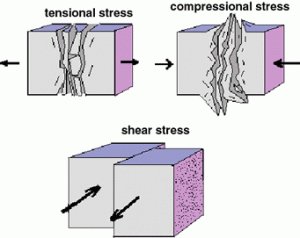
What is stress?
A force acting on a material that produces a strain
strains = deforms. A strain is a change in size, shape or volume of a material, also any kind of movement of the material (translation and tilting incl) = change in dimension/original dimension (divided)
Pressure is a stress where the force act equally from all directions
If not equal stress = differential stress
Name the three successive stages of rock/soil deformation
Elastic deformation
Rock changes shape but returns to its original form when the stress is removed (up to a limit/yield point))
Temporary, reversible.
Plastic / ductile deformation
Rock bends or flows and keeps its deformed shape after stress is removed.
high temp = near melting
high pressure = squeezed like a ball of clay
Permanent but without fracturing.
if a material can have a fair amount of plastic deformation before breaking = ductile
Brittle failure (breaks, failure point)-
Subjected to great stress that exceeds the elastic limit
Subjected to sudden stress “impact event”
Irreversible, results in faults, joints, or fractures.
Name four factors that affect rock deformation
Intensity of applied stress = pressure
Heat- temperature of the rock - high temp → more ductile
Time - applied stress over long time →ductile flow, sudden stress → brittle failure
rock composition
What is the difference between brittle and ductile deformation? Can you name examples of brittle and ductile deformation structures?
Brittle deformation
Rock breaks once stress exceeds its strength.
Occurs mostly at low temperature and pressure (near the Earth’s surface).
Produces fractures and discontinuities.
Not reversible.
Ductile deformation
Rock bends, flows, or changes shape without breaking.
Occurs mostly at high temperature and pressure (deeper in the crust).
Produces continuous structures (warping, folding).
Permanent but without fracturing.
ex
Brittle deformation structures
Faults (normal, reverse, thrust, strike-slip)
Joints (fractures with no movement)
Fractures / breccias
Ductile deformation structures
Folds (anticlines, synclines, chevron, isoclinal folds)
Shear zones (ductile flow of rock layers)
Ductile bending of sediment layers
Can soils also deform like rocks?
Yes:
Similarities to rocks:
Soils experience elastic, plastic (ductile), and brittle failure stages when stress is applied
Factors such as stress intensity, water content, time, and composition also control how soils deform.
Key differences from rocks:
Soils deform at much lower stresses because they are loose aggregates of grains, not solid crystalline materials.
Water content is crucial:
Wet soils behave more ductile (they can flow or creep).
Dry soils are more brittle (they fracture, crack, or collapse).
What is the difference between a fault (förkastning) and a fracture (spricka)?
Fracture = break, no movement.
Fault = break + movement along the fracture.
Fracture (spricka)
A crack or break in the rock with no significant displacement of the two sides.
Simply means the rock has broken.
Can form from cooling, contraction, or stress.
Example: joints (sets of fractures in granite or sandstone).
Fault (förkastning)
A type of fracture along which movement has occurred.
The rock blocks on either side of the fault plane have been displaced relative to each other.
Displacement can be vertical, horizontal, or oblique.
Examples: normal faults, reverse faults, strike-slip faults.
Name three types of joints (slag, spricka) in bedrock
Tectonic joints
Formed by large-scale stresses in the Earth’s crust (compression, tension, shear).
Often occur in systematic sets.
Unloading (sheeting/exfoliation) joints
Form when overlying material is eroded away and pressure is released.
Rock expands and cracks parallel to the surface (common in granites).
Cooling (columnar) joints
Form in igneous rocks as magma or lava cools and contracts.
Typical hexagonal patterns (e.g. basalt columns)
tension, shear, compression joints
What is the difference between “dip-slip faults” and “strike-slip faults”? (include a diagram)
Dip-slip faults
Movement is along the dip (the inclined angle) of the fault plane.
Blocks move up or down relative to each other.
Types:
Normal fault → hanging wall moves down relative to footwall (tensional stress).
Reverse fault → hanging wall moves up relative to footwall (compressional stress).
Thrust fault → a low-angle reverse fault, with very large displacements.
Think: vertical motion.
Strike-slip faults
Movement is horizontal, parallel to the strike (the compass direction) of the fault plane.
Blocks move side by side, with little vertical motion.
Types:
Right-lateral (dextral) → opposite block moves to the right.
Left-lateral (sinistral) → opposite block moves to the left.
Think: sideways motion.
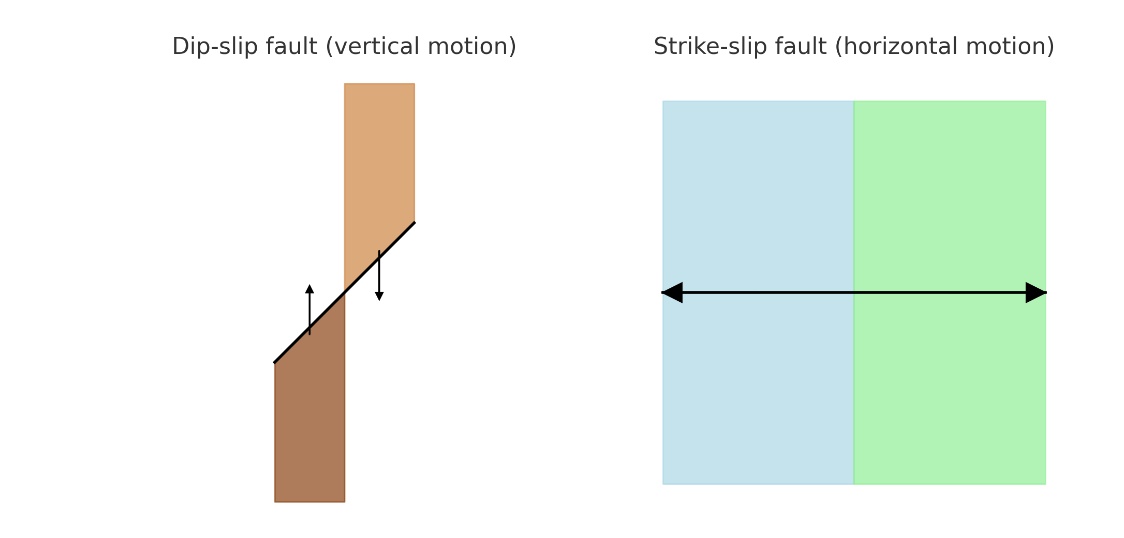
Name two types of dip-slip faults, include a diagram
Normal faults
result from horizontal tensional streses in brittle rocks
hanging-wall block moved down relative to footwall block
Reverse fault
result from horizontal compressional stresses in brittle rocks
hanging-wall block moved up relative to footwall block
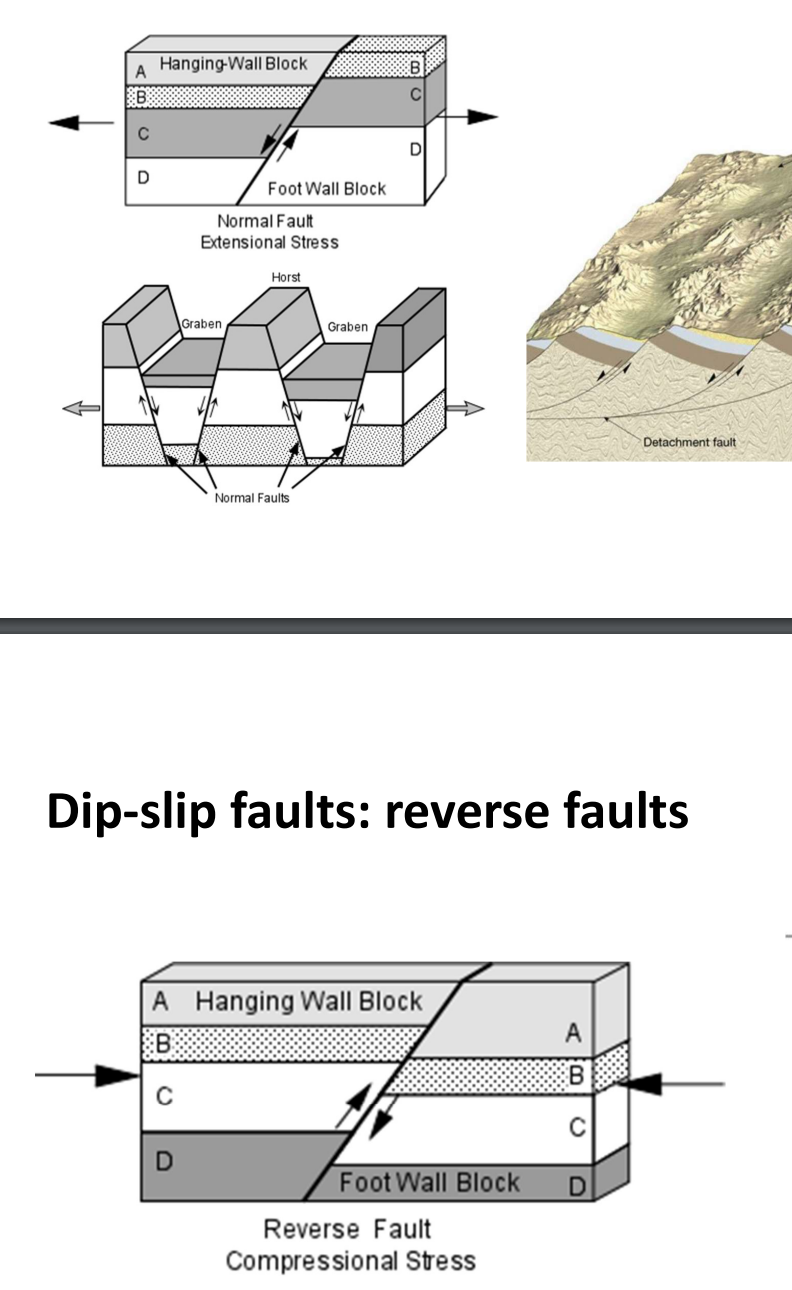
What type of differential stress forms grabens (gravsänka)?
Tensional differential stress (extension) that produces normal faults
crust is pulled apart →blocks of rocks drop down between two parallel normal faults → rift valley structure
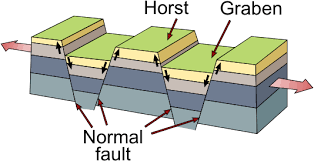
What is “fault breccia” and “fault gouge (sköl)”? do we get them in Sweden?
Movement occurs along a fault plane the rocks on either side grind against eachother
Grinding crushes the rocks into angular fragments → resulting material = fault breccia
Grinding breaks the rocks down even further into clay or siltsized particlaes → this fine grained material = fault gouge
Yes we get them in Sweden, very common
What is the “limb” and “hinge” of a fold (veck)? Use a diagram to explain
Limb (vecksida): the sloping sides of a fold. They are the parts of the rock layers between two hinges.
Hinge (veckskärna): the point or zone of maximum curvature in a fold — for example, the crest of an anticline (upward fold) or the trough of a syncline (downward fold).
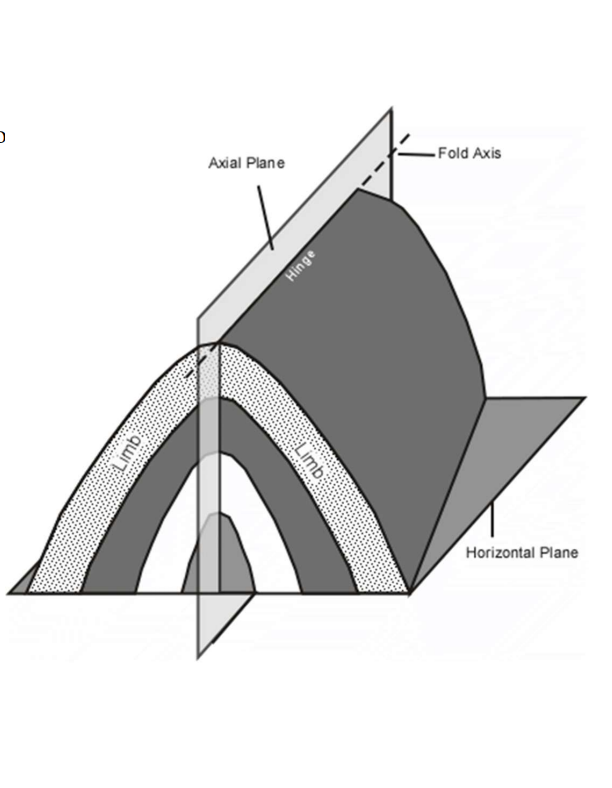
Name at least three fold types
Anticline: arch-shaped, oldest rocks in core.
Syncline: trough-shaped, youngest rocks in core.
Monocline: step-like bend in otherwise horizontal layers.
Symmetrical fold
Both limbs dip away from the axis at the same angle.
Asymmetrical fold
The limbs dip at different angles.
Isoclinal fold
Very tight fold where the limbs are parallel to each other.
Overturned fold
So strongly deformed that one limb is tilted past vertical, nearly upside down.
Recumbent fold
An overturned fold where the axial plane is nearly horizontal.
Chevron fold
A fold with sharp hinges and straight, zigzag-shaped limbs
